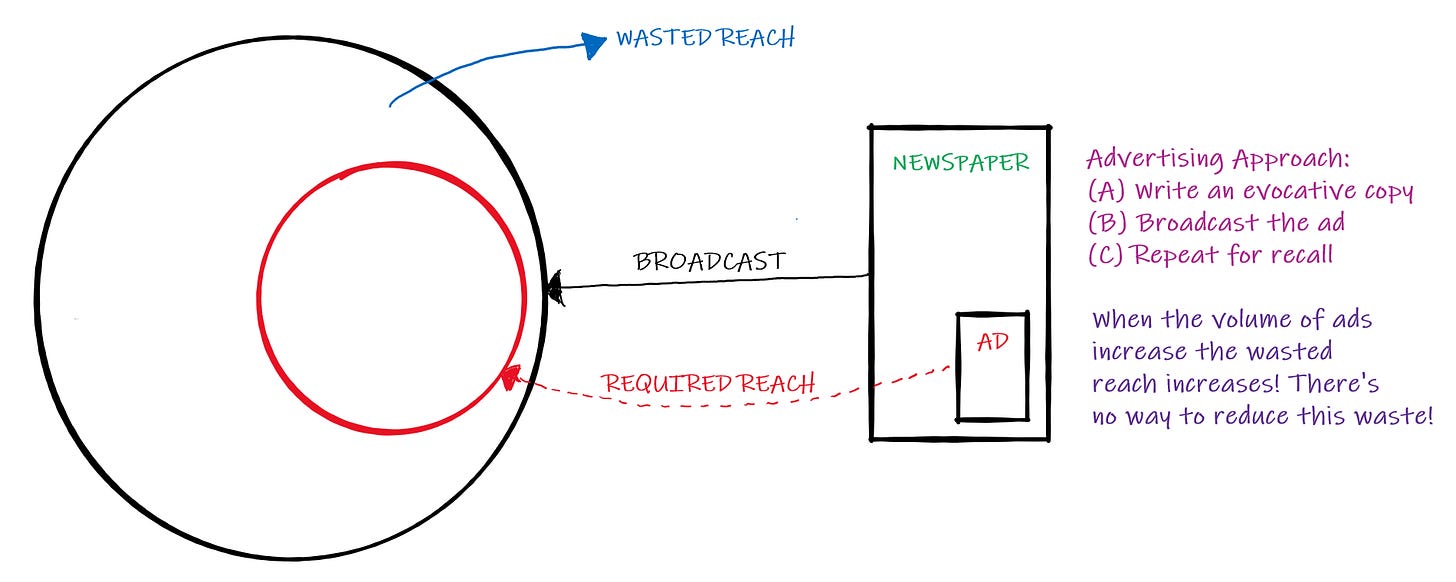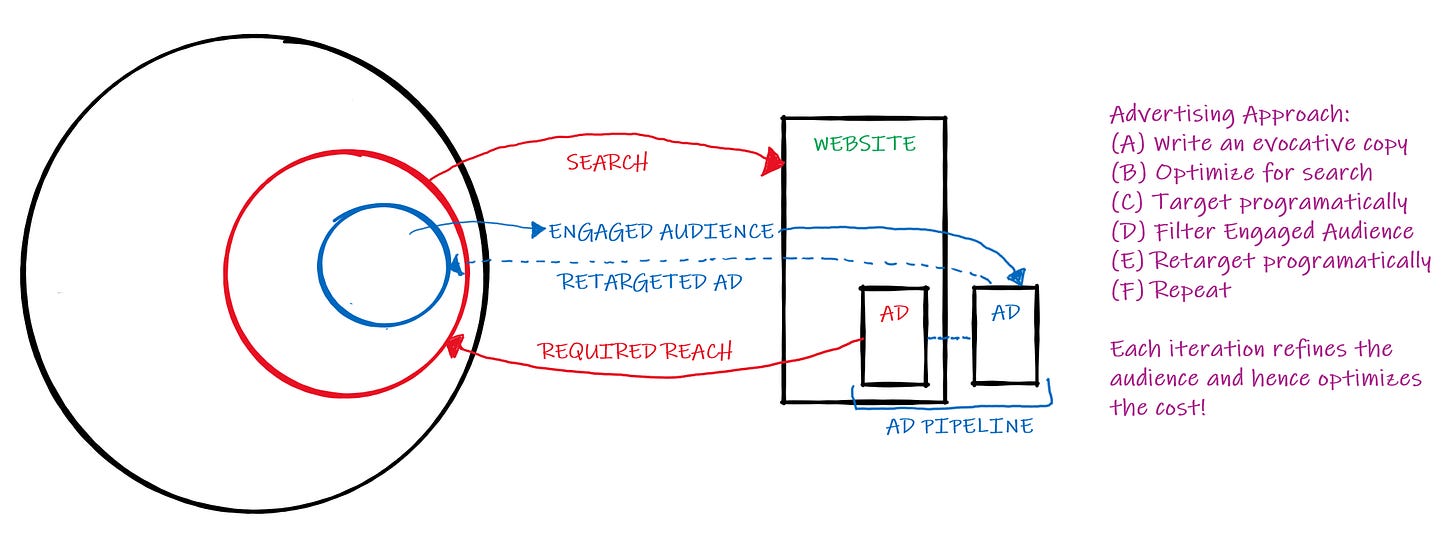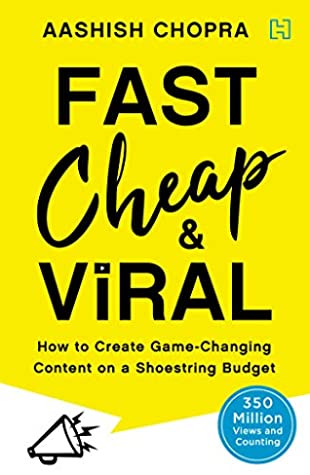Welcome to the 4th Issue of The Funnel Chemsitry!
A bit of house-keeping before we go further. Please add this email to your contact list or reply with a Hi after you read this piece. That way the next set of emails will land in your primary inbox. You won't miss anything!
The Background
Recently, a new digital marketer in my network called me up and asked "Dude! I really don't understand why this client is behind me for these retargeting ads! I tried a couple of times and the results have not been so exciting! I am trying to tell the client, but he ain't not listening!"
I have tried creating custom and engaged audience on different platforms. I got good results! Wasn't sure what this guy was not doing right! But, I had a gut feel that he might not have started right!
That's what this email will be about. To give you a heads up, it has 1570+ words and would take 6 minutes and 17 seconds to read !
Traditional Approach to Advertising
Here is the holy grail of marketing strategy!
Segment | Target | Position.
The base logic goes like this.
Divide the market into homogenous groups.
Pick up a specific group.
Change the product/service to that group.
Communicate the value of the product/service to that group.
When orders come, service them.
Repeat.
This is very sound in principle. But a critical part of this strategy didn't work as well as it should! That was the communications part. Advertising was primarily done through TV | Newspaper |Magazine | Billboards| Palmphlets| Leaflets | Brochures etc. All of these media had a serious flaw!
All of them are a one way street. The ad spoke and no one spoke back! Even if some crazy sucker did, there was no way to listen!
Think of a Television Commercial or a Newspaper Ad right now! We place the ad and hope that it reaches the right set of people and provoke them into buying our product/service. We keep repeating the ad to develop the recall. The following sketchnote summarizes this approach!
One might ask, why did we keep using the system! The answer's simple, this was the best we had and we put it to use with gusto! All good, but advertisers did grumble about an unwanted consequence. A lot of people would see the ad and many of them are not even interested in my product/service! This was Wasted Reach. See the sketchnote again and you'll understand what I am talking about!
"If they aren't interested then why are we talking to them?" asked the Finance Division. Marketing retorted "Do you know any better way?" Despite the numerous battles fought between the functions no one was any close to a solution!
Remarketing Arrives!
And then one day, Digital Marketing arrived. The next day, Programmatic Ads became possible. Ad networks started sharing data. And this solved the most important pain point of every advertiser. Targeting!
The ad-tech industry created brilliant platforms that harnessed an incredible hoard of user data. They told the advertisers and marketers that they the problem of Wasted Reach is gone. Now they can be more accountable. Now, they can clearly justify their budgets.
Armed with data and programmatic tools of analysis, the digital platforms went a step further and came up with Remarketing.
They said "Listen! all those who see your ad will not immediately buy. But there would be a few who would be more interested than the others. We know who they are because we have data on what they did after seeing the ad. We can bring them back. Just show them the ad once more." The following #sketchnote explains this logic!
So, you see! Remarketing is a highly valued tool because it promises to completely optimize Wasted Reach.
When used iteratively the platform can target more and more engaged users and begin accurately predicting who is likely to buy your product! That is amazing, right!
Now you can promise your clients that they can focus on developing the products/services and not worry about how to market them.
Ad Tech has arrived!
But then, why was my connection complaining? The next section is about how you'd use this piece of knowledge! Let's dig in.
How to use this knowledge
A single ad vs an ad-set!
A single ad was designed and repeated in the good old days of traditional advertising. We cannot carry the same paradigm to digital ads and expect it to work! The engaged users who you are retargeting might have already had an exposure to your ad! Does it make any sense to show the same piece to them again!
Instead, think of ads as a series! Each ad in the series moves the prospect in some direction. Use one set of ads to push the prospect to the next level. Another set to show a different dimension of the product/service!
When you are doing remarketing, you must stop thinking single ad copies and begin thinking ad sets that share the same campaign goals, audience profile and budget!
The copy still matters! And you must always keep it relevant!
Ads in the digital world are highly contextual! That means that they would be relevant to what the user is doing at a given instance of time. A keen understanding of why the user is on the platform, what would they be doing at that time is essential for optimizing your ad's relevance.
Research your target group! Get insights and act based on those insights. Your ad sets can be optimized better with these data points.
You can't ignore the non-engaged users
For this section, I am assuming that there are no fake accounts or click-fraud. In such an ideal world, if you have defined your user base correctly and your ad copy is relevant, you must see conversions. Think of an ad-set that uses different emotional responses.
Do multiple copies. Fear, Humor and Nostalgia are very powerful emotions. Use them. This way, the platforms will choose the best performing ads for a given target group and show that copy more. You will also know what kind of emotions people are responding to.
Thinking of ads as a drip email sequence!
Since the programmatic features of the platforms allow you to structure campaigns appropriately, think of ads as a drip-email sequence. Whether you can automate this or not depends on the platform. But the base logic is as below
Start with an ad-set addressing different emotions. Retarget Engaged Audience with a different copy that provokes taking next steps. Use a different ad-set with different emotions for non-responsive audience.
Next Steps
Are you doing retargeting ads? If not, it would be really good for you to try and learn about how you can do that. If you are, examine the results of the retargeting ads and see if those can be improved with some suggestions as above. Take time to analyze if the above tactical steps can improve your retargeting ad strategy. If this vibes with you, hit the reply button and let's talk. Or comment by clicking the below button.
Did you like this newsletter? Do you know of someone who can benefit from this? Share it by clicking on the button below:
Have you subscribed to the newsletter? If not, please do it now! I will reach out to your inbox every week with a delicious piece of snackable content that is practical and actionable!
Book of the Week
The book that I read this weak was Fast, Cheap and Viral by Aashish Copra. The book was recommended to me by Sandeep Senan, Founder of BiBox Labs, a good friend of mine.
Some of the key learnings from this book are:
#1. Content Creation is one part. But the most critical part for virality of content is it's distribution. Planning and executing content distribution is as essential as creation itself. I feel lot of content creators miss out on this.
#2. Inspirational content is highly relevant for today's digital world. Aashish suggests to write down 200 inspirational ideas. Then, keep working these into your narrative frequently. I have seen it works. Example, one tweet of Elon Musk can change the fate of a company! That is the power of inspirational personalities.
#3. Creating content around solving audience pain points is critical. If you can solve your audience's pain points then create content around that. If you cannot, then celebrate the efforts that your audience puts through. For example, content creators have to curate content by going through multiple sources and coming up with ideas. This is not an easy job. There is no tool to solve this. It has to be done the hard way. So, celebrate the effort and you will gain engagement of content creators.
#4. For making share-worthy content, it should not be about your products or services but it should be about the people who are using your products or services.
#5. Topical content or newsjacking has the capacity to reach a large number of audience very quickly and is a great substitute for online ads. But care must be taken to see how relevant it is for your brand voice.
You can buy the book here.
Those are the words of this email. See you next Thursday!






